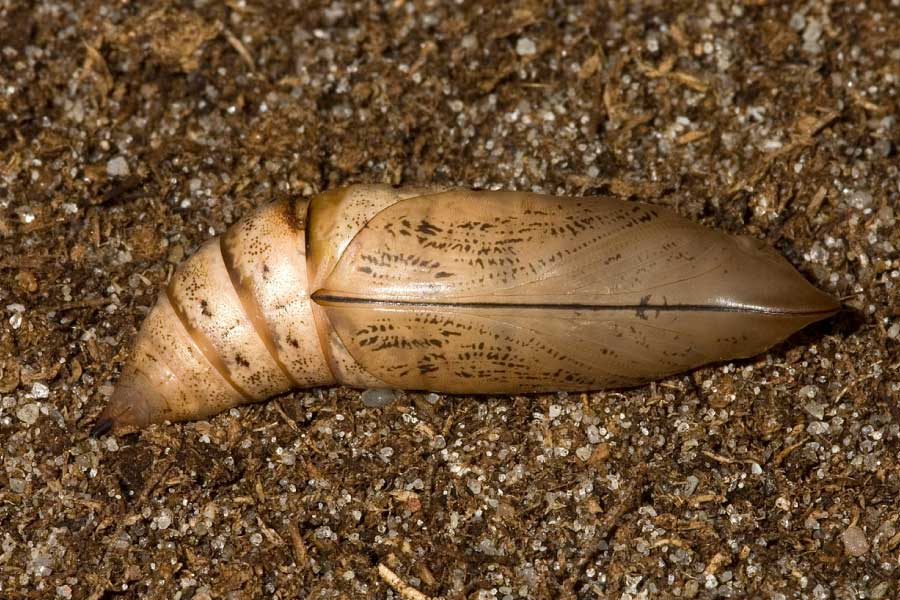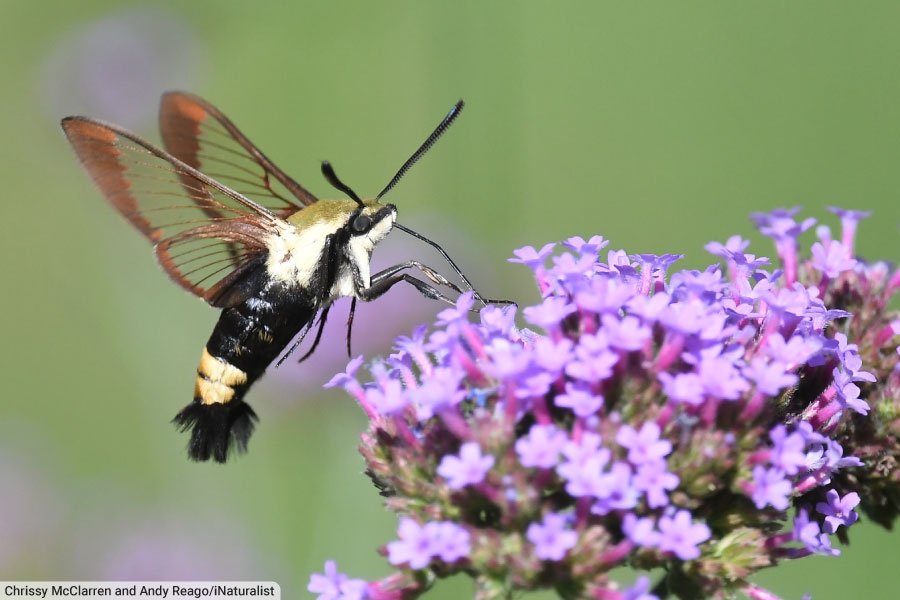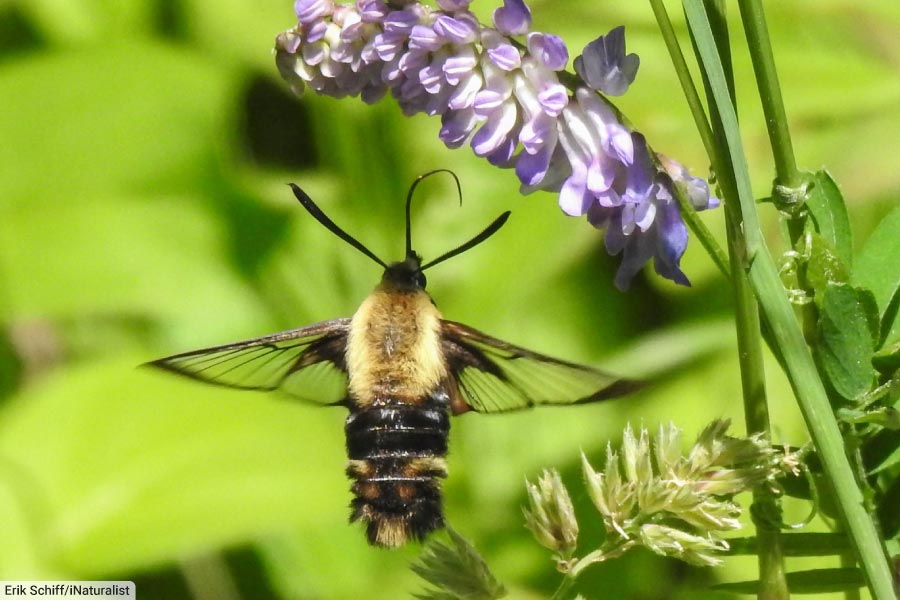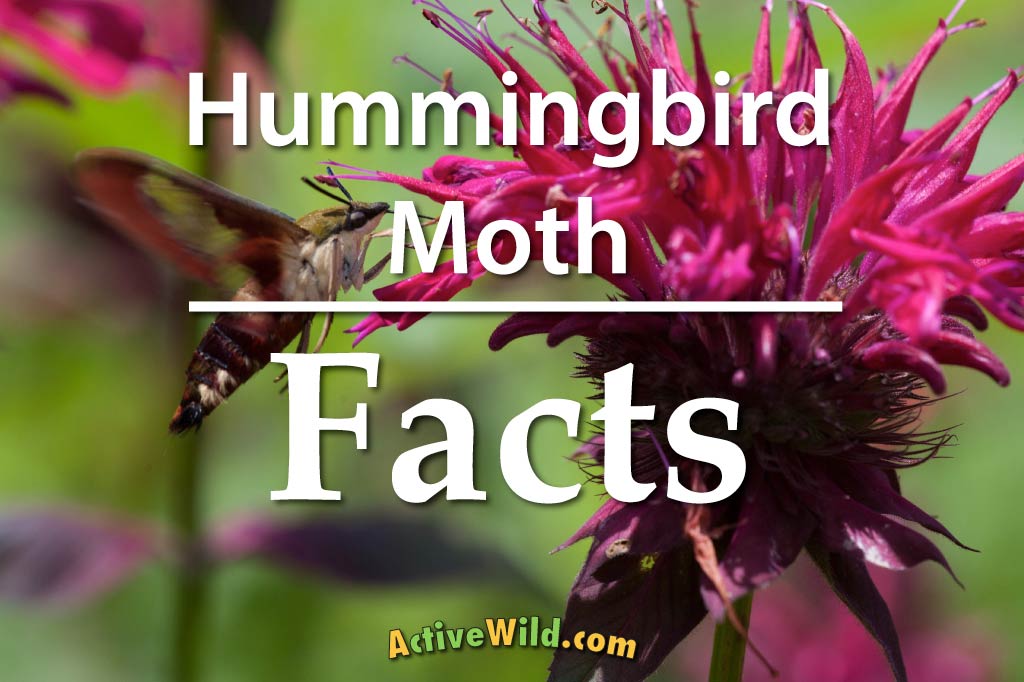As they dart from flower to flower in search of nectar, not only do hummingbird moths look like the birds after which they are named, but they also sound like them; the rapid flapping of their wings making a hummingbird–like buzz.
This page contains hummingbird moth facts, pictures and information. First we’ll find out about hummingbird moths in general before turning our attention to the five species of hummingbird moth found in the United States.
Finally, we’ll take a look at the related hummingbird hawk-moth, a species found in Europe (including the UK), Africa and Asia.
Have you seen a hummingbird moth? Report your sighting in the comments section at the bottom of the page!
Page Index
What Is A Hummingbird Moth?
A hummingbird moth is one of a number of species in the sphinx moth family, Sphingidae, that resemble hummingbirds due to their size, hovering flight style and nectar-gathering behavior. Most of the moths known as hummingbird moths are members of the genus Hemaris.
Some sphinx moths commonly known as hummingbird moths are not of genus Hemaris. These include the white-lined sphinx moth Hyles lineata (found in Central and North America), and the hummingbird hawk moth Macroglossum stellatarum (found in Europe, Asia, and northern Africa).
You can see different species of hummingbird moths further down the page, including the five species found in North America.
You can find out what terms such as ‘genus’ and ‘family’ mean on this page: Animal Classification.
The hummingbird moth in the video below is a hummingbird clearwing moth, Hemaris thysbe. This species is found across much of the United States and southern Canada.
Species
In total, there are 23 species of genus Hemaris (source: Catalog of Life). The sphinx moth family, Sphingidae, which contains Hemaris and other hummingbird moths, contains 1,605 species (source: Catalog of Life).
How To Recognize A Hummingbird Moth
In general, hummingbird moths are easy to recognize due to their size, flying style, daylight activity and nectar-gathering behavior. (Photographs of all North American species can be seen further down the page.)

Movement
Hummingbird moths are agile fliers, able to hover in one spot as well as fly backwards and sideways. Their rapid wing movements make a humming sound much like that made by a hummingbird.
Due to their size and flying style, the moths can be mistaken for hummingbirds, hence the name “hummingbird moth”.
Size
Hummingbird moths are large moths, with a typical wingspan of 40 – 55 mm (1.6 – 2.2 in.), and body length of 30 to 51 mm (1.2 – 2 in.)
Appearance
Hummingbird moths have thick, bumblebee-like bodies, long wings and a long proboscis (a long, hollow mouthpart used to drink nectar).
The coloration of hummingbird moths varies from species to species; common colors include olive green, rusty reddish brown and yellow. The colors on the animal’s back and underside are often different. Many hummingbird moths have horizontal bands or other markings on the body.
Clearwing Moths
Hummingbird moths of genus Hemaris are also known as clearwing moths on behalf of their mostly transparent wings. Although the wings of clearwing moths are initially covered in scales (like those of other moths), after the first few flights the scales fall off, leaving the wing panels transparent.
Some hummingbird moth species, such as the olive bee hawkmoth Hemaris croatica found in Europe and the Kashmir bee hawkmoth Hemaris Rubra found in Asia, don’t have clear wings.
Day Flying Moths
Unlike most moths, hummingbird moths tend to be most active during the day or around dusk. June and August are often peak months for activity. They are most often seen hovering and darting from flower to flower in their search for nectar.
Some hummingbird moth species, including the hummingbird clearwing, are migratory.
Antennae & Proboscis

Hummingbird moths have a pair of long, club-like antennae that usually widen towards the end. The proboscis is around twice the length of the body and is kept tightly coiled when not in use.
Hummingbird Moth Habitat
Hummingbird moths occur in a wide variety of habitats, but are most commonly found in meadows, cultivated gardens and suburban areas.
Food Plants
Plants commonly eaten by moths of genus Hemaris include those of the teasel family, Dipsacaceae, and the honeysuckle family, Caprifoliaceae.
Which Hummingbird Moth Species Are Found In North America?
Four hummingbird moths of genus Hemaris are found in North America:
- Hummingbird clearwing (H. thysbe)
- Snowberry clearwing (H. diffinis)
- Slender clearwing (H. gracilis)
- Rocky Mountain clearwing (H. thetis)
In addition, the white-lined sphinx moth (Hyles lineata) – a hummingbird moth of genus Hyles – is found in North America.
Scroll down the page or click here to see each of the five U.S. species of hummingbird moth in greater detail.

In Europe, moths of genus Hemaris are more commonly known as bee hawk-moths. There are three species present in Europe.
The hummingbird moth found in the UK is the hummingbird hawk-moth (Macroglossum stellatarum). The species, which is also found throughout mainland Europe and parts of Africa and Asia, is not a member of the genus Hemaris, although it is in the sphinx moth family, Sphingidae. You can read about this species in greater detail further down the page.
Hummingbird Moth Life Cycle
Like all butterflies and moths, a hummingbird moth goes through four developmental stages during its life: egg, larva, pupa and imago (adult).
Hummingbird moths breed during the summer. The female produces pheromones to attract a male, and after mating, she finds a suitable host plant on which to lay her eggs. The eggs are usually deposited on the underside of a leaf.

After hatching, the caterpillars feed until they reach their full size (usually within a couple of weeks). They then make their way to the ground where they pupate, forming a cocoon under leaf litter or buried in the soil.
In colder areas, a single generation is produced each year; in warmer areas, two or three generations may be produced in a year.
Depending on the species, an adult hummingbird moth may live as long as seven months or as little as three weeks.
Hummingbird Moth Caterpillars

Hummingbird moth larvae (caterpillars) are among several types of sphinx moth caterpillars known as hornworms due to the horn-like spike that projects from the rear the body.

Hummingbird moth caterpillars should not be confused with the plant-damaging tomato hornworm or tobacco hornworm, which are the larval forms of the five-spotted hawkmoth and tobacco hawk moth respectively.
The eggs of hummingbird moths are tiny, round, and glossy pale green in color. The cocoons of most species have a glossy surface.
What Do Hummingbird Moths Eat?
Hummingbird moths feed on nectar, often seeking out the same long-necked flowers as hummingbirds.
The moths are particularly attracted to plants in the honeysuckle family, including viburnum and snowberry. They also feed on the nectar of flowers such as horse mint, beebalm, phlox, verbena, dogbane, cardinal, red valerian, salvia, and buddleia (butterfly bush).
The caterpillars eat leaves and are more restricted in their choice of diet than the adult moths. The primary host plants are hawthorns, cherries, honeysuckles, snowberries, teasels and dogbane.
Are Hummingbird Moths Endangered?
None of the hummingbird moth species have been listed by the IUCN as endangered. However, some species may be in decline locally. For example, the slender clearwing (H. Gracilis) is considered threatened in Connecticut.
Hummingbird Moths Found In North America
Hummingbird Clearwing (Hemaris thysbe)

The hummingbird clearwing is a species of hummingbird moth found in the United States and Canada. It is found in Alaska, across Canada, and throughout the eastern United States to Texas and Florida.
The species typically has an olive green head and thorax, burgundy abdomen, and pale undersides, although colors vary between individuals.

The wings have clear central panels and brown / burgundy / olive green edges. The species’ wingspan is 4 – 5.5 cm (1.6 – 2.2 in)
The hummingbird clearwing can be differentiated from the snowberry clearwing by its pale yellow legs, and by the lack of banding on the side of the thorax.
Snowberry Clearwing (Hemaris diffinis)

The snowberry clearwing is named after the snowberry plants on which the caterpillar feeds. The snowberry clearwing’s coloration varies from individual to individual, but the thorax is typically gold or olive-gold, and the abdomen black with one or two yellow / gold segments near the end.
The gold / black coloration of the snowberry clearwing means that it can easily be mistaken for a bumblebee.

The species if most abundant in the Eastern United States and the southeast of Canada, although it has been seen both in California and Alberta, Canada.
The snowberry clearwing can be distinguished from the hummingbird clearwing by the black stripe that stretches from the insect’s head, across the eye and under the wings on the thorax, and by its black legs.
Rocky Mountain Clearwing / California Clearwing (Hemaris thetis)

As its name suggests, the Rocky Mountain clearwing is found in the western United States. Its range stretches from southwest Canada to northwest Mexico.
The species’ coloration is varied, but typically the head and thorax are olive-green and the abdomen is black with one or more adjacent yellow / gold segments.
Slender Clearwing / Graceful Clearwing (Hemaris gracilis)

The slender clearwing is very similar to the hummingbird clearwing, having an olive head and thorax and burgundy abdomen.
The slender clearwing can be identified by the thin white band around the abdomen where it meets the thorax; the red-brown stripe running along the side of the thorax from behind the eye and under the wings to the abdomen; and the red-brown color of the upper surface of its legs.
The species is mainly found in the eastern United States.
White-Lined Sphinx (Hyles lineata)

With a wingspan of between 2 and 3 inches, the adult white-lined sphinx is larger than the hummingbird moths of genus Hemaris found in the United States. It is also more likely to be seen flying at dusk and during the night than the day-flying clearwings.
In the video below, a white-line sphinx moth can be seen flying from flower to flower in search of nectar.
The species’ long forewings are dark brown and black, with a white central stripe and several thinner cross-stripes. The hindwings are black with a wide pink central stripe. The abdomen is marked with several white and black stripes.
The white-lined sphinx is found throughout the United States as well as in southern Canada and Central America.
Other Hummingbird Moths
Hummingbird Hawk-Moth (Macroglossum stellatarum)

The hummingbird hawk-moth is a sphinx moth found in Europe, Asia, and Africa. It is similar in appearance to hummingbird moths (although it does not have clear wings), but is not in the genus Hemaris.
In the UK the hummingbird hawk moth is seen from late spring to early autumn. It has orange-brown wings, grey head and thorax, and black abdomen with white patches. The undersides of the head and thorax are white / grey. The wingspan ranges from 50 to 58 mm.
As its name suggests, the hummingbird hawk moth resembles a hummingbird when foraging, as it hovers, and darts sideways and backwards as it flies from flower to flower. Like the hummingbird moths of genus Hemaris, it also makes a humming sound when flying.

